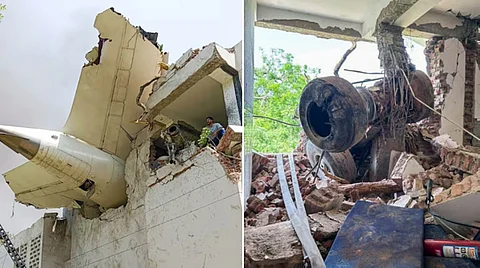
- Home
- Live Blog
- Breaking News
- Top Headlines
- Cities
- NE News
- Sentinel Media
- Sports
- Education
- Jobs

The catastrophic plane crash of the London bound Air India flight with 242 people on board – passengers, pilots and crew members – has left India and the rest of the world shocked, with people struggling to understand what went wrong. Initial reports say that the pilot of the ill-fated aircraft had issued a Mayday call a few minutes after it had taken off from Sardar Vallabhbhai Patel International Airport in Ahmedabad that implied that the aircraft had encountered a critical emergency situation. The probe ordered by the Directorate of Civil Aviation (DGCA) and Aircraft Accident Investigation Bureau (AAIB) will bring to light the actual cause of the crash – one of the worst in aviation history – which has put the spotlight on aviation safety in the country. The recovery of the orange-coloured ‘black boxes’ – the Cockpit Voice Recorder and Flight Data Recorder – will be crucial for the expeditious completion of the probe, as data captured by these provide vital clues about the crash to the investigators. A miracle survivor, who is reported to be a British national, recuperating in a hospital, is expected to provide the crucial information as to what had actually happened during the few minutes from the takeoff to the plane plummeting and hitting a residential complex of a medical college and turning into a huge fireball. According to the AAIB, the sole objective of the investigation of an accident/incident shall be the prevention of accidents and incidents and not to apportion blame or liability as stipulated by the Convention on International Civil Aviation Organisation (ICAO) and Rule 3 of Aircraft (Investigation of Accidents and Incidents), Rules 2017. The National Aviation Safety Plan (NASP) 2024-2028 prepared and released by the DGCA provides strategic direction for improvement of aviation safety management for the period till 2028. It includes five strategic goals which include achieving a continuous reduction of operational safety risks, strengthening safety oversight capabilities, implementing an effective State Safety Programme, increasing collaboration at the international level and expanding the use of industry programme and safety information sharing networks by service providers. The goal of achieving a continuous reduction of operational safety risks is linked to the following eight national high-risk categories: mid-air collision, controlled flight into terrain, runway excursions, wildlife (bird/animal) strikes, loss of control in-flight, runway incursion, ramp safety and deficient maintenance. The Parliamentary Standing Committee on Transport, Tourism and Culture, in one of its reports on ‘Issues related to safety in the civil aviation sector’, recommended that the DGCA must regularly coordinate with the Airport Authority of India, various airport operators and airline operators and ensure the implementation of its specifications and guidelines regarding aviation safety and the installation of various state-of-the-art technologies for the prevention of aircraft accidents/malfunctioning. The Committee underscored the need for ensuring that all regulations are followed in the import as well as maintenance of aircraft/aircraft engines, which is absolutely critical from a safety point of view. It also called for the carrying out of surveillance and spot checks at regular intervals to ensure that the aircraft and engines are maintained in airworthy condition so as to ensure the safety of aircraft flights at all times. The Indian aviation industry has witnessed a boom over the past decade, and aviation safety has become more crucial with the rise in the number of aircraft, passengers and flights. Official data shows that during nearly six and a half decades till 2014, the total number of passengers flying annually in India was 10 crore 38 lakh. In the subsequent ten years, from 2014 till 2024, the number of passengers doubled to 22 crore 81 lakh. The number of airports in India increased from 74 in 2014 to 159 in 2024, and the number of aircraft grew from 340 in 2014 to over 840 in 2024. The spectacular growth has led to an increase in demand for trained pilots, which the government estimates at 30,000 to 34,000 over the next ten to fifteen years. While the growth is quite impressive, it also brings the challenges of safety oversight. Strengthening DGCA and AAIB with adequate human resources and increased budgetary support has become an urgent need of the hour to meet the challenges of aviation safety management to match the scale of growth in the industry in the country. Bringing more transparency in safety management and the system being more responsive to passengers’ feedback on every aspect is essential to boost confidence over measures being taken to prevent accidents/incidents involving aircraft and ensure airworthiness of aircraft by all airliners. While it is premature to rush to any conclusion about the cause of the crash, all aviation stakeholders in the country must go the extra mile and take proactive measures for aviation safety and regulation in the wake of the devastating plane crash in Ahmedabad. Thursday’s deadliest air tragedy is a wake-up call for tightening all loose ends in aviation safety.